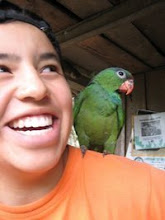
The above picture is a typical image of the Northern part of Namibia - sunset over the Oshanas (sort of like small lakes that are everywhere after the rainy season) and palm trees, usually lots of livestock running around and causing traffic as well... :)
I'm posting this very late - indeed this story was written about 2 months ago, but I wanted to keep you all updated. I left Central America in December of 2008 and returned home to Namibia immediately afterwards. I spent the holiday season traveling with my parents and looking for a job. This article focuses on short-term consultancy work I did for Integrated Environmental Consultants Namibia (IECN), for 8 weeks between February and early March 2009. Soon I will post a new entry about my current job.
I have mainly focused on the evaluation of a coastal awareness campaign, by undertaking a survey in all of the coastal regions of Namibia. Basically, my coworkers and I have gone around and interviewed approximately 250 local citizens and members of affiliated institutions -- such as the provincial Councils and environmental Conservancies -- to assess the impact of the campaign since its commencement a year and a half ago. As the entire western border of Namibia is the ocean, you can imagine the incredible distances that we had to cover in order to carry out the survey. In one week we went south to the small German-style port of Lüderitz, stopping at various sites along the way for the interviews. Then last week we headed out into the unbelievably remote Kunene Region with the IECN land cruiser packed full with jerry cans, food, camping equipment, 2 spare tires, a toolbox and more.

We experienced bad roads like never before. At times sandy; at times stony; at times wet, steep and muddy (or some unbelievably messy combination thereof). It seemed like our car had seen it all when we drove straight down a dry riverbed composed solely of boulders, racing to catch up with our translator-guide who enjoyed driving his Government-owned truck as fast as he possibly could. (I’m talking 75mph on gravel roads.) And this was just the first day. That night found us camped next to the beautiful Hoanib riverbed. We were up late because we had decided to blend in with local culture and slaughter a goat for dinner. By dinner I mean that we ate the meat for the next 3 days straight. We were unable to buy purified water anywhere, but beer was available everywhere so we drank that for 3 days straight too.
The food and drink put us in high spirits even after we discovered that our car battery had died when we left the lights on in the dark and we had no jumper cables. The next morning we found ourselves stranded in practically every way you can think of. Our translator-guide had woken up early in the morning, drove across the riverbed and gone to the nearest small settlement called Purros to find jumper cables. When he did not return we suspected the worst – if not dead or maimed then drunk and gone forever. But soon we realized that the dry river to Purros had flooded overnight so he couldn’t have returned even if he wanted. It is the flash-flood season in Namibia -- a country with no permanent rivers within its borders -- so in the rainy season dry riverbeds in the desert can suddenly fill with water from rainfall miles away.

Certainly, the Hoanib was no calm stream that morning! It had become a raging torrent about 100 feet across with rapids, rocks, unreliable sandbars – altogether impassable by any sort of vehicle. So that was how we found ourselves trapped on the wrong side of the river from where we had to go next: Our car battery was dead, the car petrol (gas) was low; there was no cell-phone service and we had no food as our goat-meat and pots were in the back of the truck that our guide drove, and he had gone awol.
Somehow, we made it out of there. With the help of some tourists also stranded at the campsite, we jump-started our car. A nice British lady fed us breakfast and directed us to a nearby lodge where we could buy petrol. And then there was nothing to do but wait for the water level to drop. Around 3pm we heard honking across the river and looked up to see our guide on the other side. He gestured wildly and somehow managed to communicate to us that we should go to another spot further downriver. We felt we had no choice but to attempt the crossing before any new afternoon rains could catch up with us. We put the Land Cruiser into 4-wheel drive and ventured forward. Churning that car through thigh-deep water was certainly a sight to behold: The roar of the engine clashed with the sound of rushing water, as she swayed perilously from side to side. Somehow she finally made it across and we were able to continue on our way towards the coast. We crossed several smaller rivers along the way as well, but by this point we were experienced - I climbed onto the Land Rover's roof-rack and took some pictures.

I’m pleased to report that we ultimately survived the trip. We journeyed along the coast through the famous Skeleton Coast Park (famous for shipwrecks and uninhabitability) and conducted interviews at Torra Bay - a small fishing town. We passed through gravel plains and never-ending ranges of dunes before we finally reached the ocean. We then continued south to do interviews for a few days in Swakopmund. The final report took a week and a half to write but we did it.
Look out for more desert research adventures upcoming!











